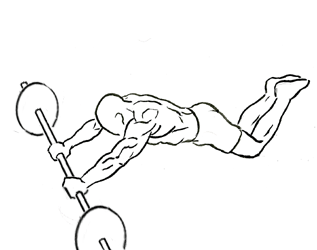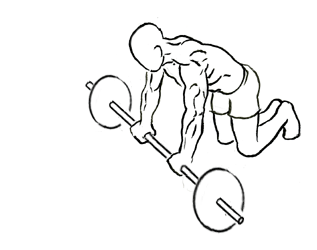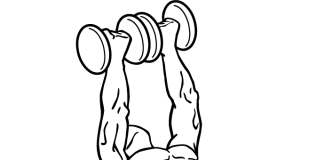Last Updated on September 25, 2014
The barbell ab rollout on knees is a powerful exercise that targets your core, lower back, and upper body. It’s a more intense variation of the traditional ab roller, offering a robust workout for those looking to strengthen and define their midsection. This guide will walk you through the steps, benefits, common mistakes, and variations of the barbell ab rollout to help you master this challenging exercise.
Steps to Perform the Barbell Ab Rollout on Knees
- Setup: Place a barbell loaded with 5-10 lb plates on either side on the floor in front of you.
- Starting Position: Kneel on the floor with your knees steady and grip the barbell with an overhand grip, shoulder-width apart.
- Engage Your Core: Tighten your core, shoulders, and glutes. Shift your weight forward so that your shoulders are over the bar, and tuck your pelvis under to create a hollow hold shape.
- Roll Out: Slowly and with control, roll the barbell forward as far as you can while keeping your back straight and arms extended. Avoid letting your hips drop.
- Return: Pause briefly at full extension, then roll the barbell back towards your knees by engaging your core and pulling with your lats, returning to the starting position.
Benefits of the Barbell Ab Rollout
The barbell ab rollout is an effective compound exercise that engages multiple muscle groups, including:
- Rectus Abdominis: The primary muscle targeted, contributing to the “six-pack” look.
- Erector Spinae: Muscles along the spine that help maintain posture.
- Transverse Abdominis: Deep core muscles that stabilize the spine.
- Shoulders and Arms: The deltoids and triceps are engaged to stabilize and control the movement.
- Lats and Chest: These muscles assist in the rolling motion and help pull the barbell back.
Common Mistakes and How to Avoid Them
- Dropping the Hips: Allowing your hips to drop can place undue stress on your lower back. Keep your stomach braced and hips aligned with your shoulders.
- Lack of Core Engagement: Failing to engage your core can lead to hip drop and back strain. Focus on maintaining tension in your core muscles throughout the movement.
- Improper Shoulder Positioning: Starting with your shoulders too far back can increase strain on your arms and shoulders. Ensure your shoulders are over your wrists and slightly tuck your pelvis under.
- Overextending: Rolling out too far can lead to loss of control and potential injury. Only roll out as far as you can maintain proper form and control. Gradually increase your range of motion as you build strength.
Variations of the Barbell Ab Rollout
- Standing Ab Rollouts: For a more advanced challenge, perform the rollout from a standing position. This increases the range of motion and requires greater core strength and stability.
- Resistance Band Rollouts: Attach resistance bands to the barbell to add an extra challenge. This variation is more suited for advanced users and helps in working on shoulder strength.
- Rollouts to Push-ups: Combine the rollout with a push-up for a full-body workout. After rolling the barbell back to the starting position, perform a push-up before the next rollout.
Tips for Effective Barbell Ab Rollouts
- Warm-Up: Always warm up your core and shoulders before performing ab rollouts to prevent injury.
- Controlled Movements: Perform the exercise slowly and with control. Rushing through the movement can increase the risk of injury.
- Breathing: Inhale as you roll out and exhale as you pull the barbell back. Proper breathing helps maintain core engagement and control.
- Progress Gradually: Start with a limited range of motion and gradually increase as you build strength and confidence.
Conclusion
The barbell ab rollout on knees is an excellent exercise for building a strong, defined core. By following the proper steps, avoiding common mistakes, and incorporating variations, you can maximize the benefits of this challenging exercise. Remember to engage your core, maintain control, and progress gradually to prevent injury and achieve the best results. Happy rolling!








